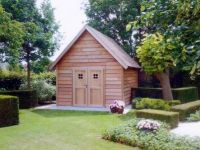The main office Christiaens Yvan will be closed till Monday 12 January 2026.
 De ruimste keuze in exclusieve tuinhuizen, carports, poolhouses en paardenstallen vind je bij Tuinhuizenfabrikant Yvan Christiaens.
Tuinhuizenfabrikant Yvan Christiaens levert en plaats in gans België. Er is altijd een servicepunt in uw buurt.
De ruimste keuze in exclusieve tuinhuizen, carports, poolhouses en paardenstallen vind je bij Tuinhuizenfabrikant Yvan Christiaens.
Tuinhuizenfabrikant Yvan Christiaens levert en plaats in gans België. Er is altijd een servicepunt in uw buurt.
Annual winter break from Friday 19th December 2025. We will be back on Thuesday 13th January 2026.
At the Garden House Manufacturer, delivering quality and personal contact is of crucial importance.
It's not about how many customers are served, but how well they are served.
Yvan Christiaens, manufacturing garden houses for more than 40 years
For over 40 years garden house manufacturer Yvan Christiaens has been designing, producing and delivering garden and pool houses, chalets, granny annexes, garages, log cabins, horse stables and doghouses at the best price-quality ratio. The long experience combined with our state-of-the-art machinery enables us to manufacture any wooden annex in the most professional manner possible. A beautiful standard garden house can be supplied 4 to 6 weeks after order! It takes us a bit longer to deliver a customised garden house – our speciality; it all depends on the requested dimensions. A ready-made construction kit or a customised garden house? Endless combination options through our extensive service network; from classic to cottage, from modern to design. We work with our own installation team, and also offer earth and concrete works.
Thoroughly enjoy yourself in style …. throughout all 4 seasons, year in, year out.
Ask us for an advisor nearby and receive your free Catalogue.
Ontdek onze inspiratieruimtes

Bij ons vindt u geen standaard expo-modellen of rijen identieke tuinhuizen.
Wij kiezen voor iets bijzonders: inspiratie!
In onze inspiratieruimtes laten we u kennismaken met stijlen, materialen en afwerkingen die perfect passen bij uw wensen. Wanneer u kiest voor een houten bijgebouw gaat het niet alleen om het product, maar vooral om de ervaring, de ideeën en het advies die u meekrijgt.
Bij uw bezoek (liefst op afspraak) wordt u persoonlijk ontvangen. U krijgt meteen een indruk van de vele mogelijkheden en toepassingen. Vaak brengen klanten al eigen schetsen, ideeën of sfeerfoto’s mee. Samen bekijken we stap voor stap wat het beste aansluit bij uw budget en wensen.
Wil je goed voorbereid één van onze inspiratieruimtes bezoeken?
Met onze snelle rekentool (3 minuten!) berekent u vooraf meteen een eerste richtprijs.
Wat mag u verwachten in onze inspiratieruimtes?
Het resultaat van uw bezoek? U verlaat onze inspiratieruimte niet alleen met frisse ideeën, maar ook met een goed gevoel én een helder plan voor uw op maat gemaakte bijgebouw. Wij kijken ernaar uit u te verwelkomen in één van onze inspiratieruimtes en samen met u te bouwen aan een prachtig eindresultaat!
Een tuinhuis dat blijft !








Popup Kijkboek 2025
Kijkboek 2025
Gratis bij u thuis
Cashback-nazomer-2025-einde
Deze actie is afgelopen op 18/10/2025, maar u kunt uw aanvraag nog indienen tot 18/12/2025.
Koop een tuinhuis, carport of poolhouse en ontvang een cashback van € 250.
Met de najaarsbeurzen in aantocht stelt Christiaens Yvan u graag deze cashback-actie voor.
- Koop tijdens de nazomer een tuinhuis, carport of poolhouse van Christiaens Yvan en ontvang een cashback van € 250 op jouw bankrekening. De actie komt vanuit de fabriek als dank voor uw vertrouwen.
- Actie geldig voor alle aankopen gedaan tussen 18 augustus en 18 oktober 2025 van minimum 5.000,- EUR incl. btw (excl. plaatsing, grond-en betonwerken, leveringskosten) én geleverd en geplaatst ten laatste op 18 december 2025.
- Het enige wat u moet doen is zich registreren, ten laatste op 18 december 2025 (tot 24h00). Neem uw factuur en onderhoudsboekje bij de hand en laat uw gegevens achter.
Door mee te doen, verklaar je je akkoord met het reglement dat je hier kan raadplegen. Actie enkel voor klanten.
Make your appointment
Make your appointment in our presentation room. Or click here.
We'd like to discuss our large choice and all garden house options and possibilities.
Preferably on weekdays in the afternoon.
If you prefer an appointment after 16h00, please click here.
Koop en maak kans
Koop een tuinhuis en maak kans op een reischeque.
Koop een tuinhuis, carport of poolhouse van Christiaens Yvan en maak kans op een reischeque ter waarde van 3.000,- EUR.
Deze cheque zal bij het deelnemend reisbureau inwisselbaar zijn voor een reis naar keuze, op te nemen binnen het jaar.
De actie loopt voor alle aankopen gedaan tussen 01 september en 31 oktober 2023 van minimum 5.000,- EUR incl. btw.
Het enige wat u moet doen is zich registreren, ten laatste op 31 oktober 2023 (tot 24h00). Neem uw bestelbon bij de hand en laat uw gegevens achter.
Door mee te doen, verklaar je je akkoord met het wedstrijdreglement dat je hier kan raadplegen. Wedstrijd enkel voor klanten.
popup Uitverkoop Expomodellen
Uitverkoop Expomodellen | Weg=Weg
Sales Points and Service Points
Personalized advice and guidance for your ideal garden shed or carport.
Our employees, both at the head office and at our dealers at the sales points, will be happy to assist you further. Make an appointment here below in our showroom and get to know our wide range of products and options. Together, we will find your ideal garden shed or carport.
 Head Office
Head Office Service Point
Service Point Sales Point
Sales Point Contractor
Contractor
There is sure to be a Sales Point or Service Point in your area, ask for it.
Every product is distributed throughout Europe via our dealer network. These carefully selected sales points and service points meet our strict quality requirements and can do all the work for you. Our Service Points can prepare the foundations, assembly and take care of the finishing, giving you the after-sales service that you desire. All of our Sales Points and Service Points use the same prices.
Contact us for the name and address of a Sales Point or Service Point in your area and we'll send you our Catalogue. You will receive a guide "How to request for a quotation", a form for requesting a quotation, some prices and a gift voucher.
With these documents you will be well informed to visit your Sales or Service point.
Digital Catalogue Christiaens Yvan
Have a look into the Christiaens Yvan Catalogue.
132 pages full of ideas and exclusive Garden Houses, Carports & Poolhouses. For more than 35 years the one and only garden house manufacturer. Christiaens Yvan delivers and installs garden houses all over Belgium.
















































